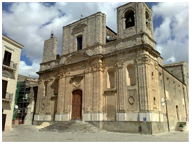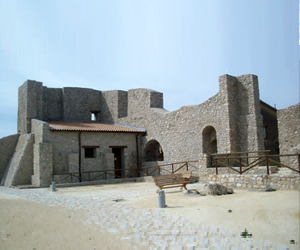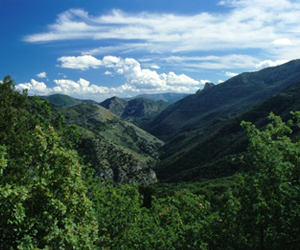Church of Maria Santissima Assunta Church of Maria Santissima del Lume Church of Maria Santissima del Carmelo The Church of Maria Santissima del Carmelo (XVI century) is located in via XX Settembre. is a single nave and has a portal with columns with Corinthian capitals. Church of San Giovanni Battista Church of Sant’Antonio. Church of Madonna della Pietà (XVIII century). Sanctuary of San Nicola Inside the Sanctuary of San Nicola (XVI century), Byzantine rite, is guarded the “vara” of the Holy Cross, carved by Marabitti in 1639. Sanctuary of Maria Santissima delle Grazie (XVI century). Sanctuary of Santa Maria del Rifesi. Palazzo Municipale (ex Palazzo Dara) Palace of the eighteenth century characterized by an arch of entry through which you enter in an internal courtyard with a fountain. The building is owned by the municipality since 1948. Palazzo dei Baroni Mancuso The eighteenth-century palace located in the main square and equipped with more entrances, one in via Vittorio Emanuele and the other in via Armando Diaz. The palace, perhaps originally the residence of the Barons Schirò, passed to the barons Mancuso. Casa d’infanzia di Francesco Crispi. Villa del Barone Vincenzo Mancuso Pasciuta Located almost at the end of Viale Vittorio Veneto, was built between the end of nineteenth and the first years of the twentieth century. The house, whose garden was filled by a modern building, was decorated with paintings by Giuseppe Enea, painter-decorator of Palermo also active in the Teatro Massimo in Palermo. Adjacent to the garden was another land that was donated by Vincenzo Barone in favor of the train station which was inaugurated in 1920. Villa comunale (o parco della Rimembranza) Located in Viale Vittorio Veneto, its construction began in the postwar period (1920), by order of municipal authorities. The park is dedicated to the memory of Palazzesi fallenin the First World War, there were planted 40 trees, as many as the fallen. Fontana di piazza Umberto I Dating back to 1608; it exhibits on the gravestones, the name of the directors who commissioned the building. To realize the fountain, with a characteristic octagonal shape, were Nicolo Gagliano and Vito Terms (1607). Lavatoio comunale It was built in 1938, during the fascist regime, by order of Benito Mussolini, visiting the country on the occasion of the inauguration of the dam of the lake Gammauta. Mussolini, it is said, saw some women washing clothes at the headwaters of Fontana Grande and decided to build a Lavatoio comunale. The building was restored a few years ago. Castle of Palazzo Adriano (secolo XIV) Pietra di Salomone On the west side of Pietra di Salomone there are some rooms, excavated by the Byzantines and used as lookouts. Pietra dei Saraceni There is carved a staircase leading to a circular well, probably for rainwater collection. Natural Reserve “MONTI DI PALAZZO ADRIANO E VALLE DEL SOSIO” The Church of Maria Santissima Assunta (XVI century), Byzantine rite, is located in Piazza Umberto I. It was built in 1532 and renovated in 1770, when it was enlarged, and thus lose its original shape of a Greek cross. The Church, as well as being a monument that lists the basic elements of Eastern theology, also contains the graves of some famous people of the Albanian community. The interior has three naves decorated with gilded stucco and ten large paintings dating from the mid-nineteenth century. The main façade is carved stone. The side steps are tufa blocks: According to popular tradition, was the custom of King Ferdinand IV of Bourbon arrive on horseback to the entrance of the church whenever he went to Palazzo Adriano. The church has a sacristy and a bell tower, rebuilt in the late nineteenth century. Some chapels were probably decorated with the contribution of the notables of the place, as the barons DiMaggio for the right nave or barons Mancuso for the chapel to the right of the presbytery. Notable paintings by Giuseppe Palermo Patania on the walls of the nave. A note of interest is also the Vara Processional, containing the Holy Crucifix carried by Albanian refugees in the country before 1482.
The Church of Maria Santissima Assunta (XVI century), Byzantine rite, is located in Piazza Umberto I. It was built in 1532 and renovated in 1770, when it was enlarged, and thus lose its original shape of a Greek cross. The Church, as well as being a monument that lists the basic elements of Eastern theology, also contains the graves of some famous people of the Albanian community. The interior has three naves decorated with gilded stucco and ten large paintings dating from the mid-nineteenth century. The main façade is carved stone. The side steps are tufa blocks: According to popular tradition, was the custom of King Ferdinand IV of Bourbon arrive on horseback to the entrance of the church whenever he went to Palazzo Adriano. The church has a sacristy and a bell tower, rebuilt in the late nineteenth century. Some chapels were probably decorated with the contribution of the notables of the place, as the barons DiMaggio for the right nave or barons Mancuso for the chapel to the right of the presbytery. Notable paintings by Giuseppe Palermo Patania on the walls of the nave. A note of interest is also the Vara Processional, containing the Holy Crucifix carried by Albanian refugees in the country before 1482. The Church of Maria Santissima del Lume (XVIII century), Latin Rite, is also located in Piazza Umberto I. It is the Mother Church of Palazzo Adriano. Built by Baron Schirò in the forties of the eighteenth century, on the ancient church of San Sebastiano. The church has three naves with twelve columns in two blocks; side altars are decorated with precious paintings of great artistic value belonging to the school of Pietro Novelli. The main façade has three recesses containing statues of St. Peter, St. Paul and St. Michael the Archangel. The side facades are made of stone, while the vault and the apse are decorated with frescoes. The church has a sacristy and bell tower. The church was designed by Francesco Ferrigno of Palermo, the bell tower was built in 1751 and decorated in 1900 with a clock built by brothers Scibetta of Bisacquino (PA).
The Church of Maria Santissima del Lume (XVIII century), Latin Rite, is also located in Piazza Umberto I. It is the Mother Church of Palazzo Adriano. Built by Baron Schirò in the forties of the eighteenth century, on the ancient church of San Sebastiano. The church has three naves with twelve columns in two blocks; side altars are decorated with precious paintings of great artistic value belonging to the school of Pietro Novelli. The main façade has three recesses containing statues of St. Peter, St. Paul and St. Michael the Archangel. The side facades are made of stone, while the vault and the apse are decorated with frescoes. The church has a sacristy and bell tower. The church was designed by Francesco Ferrigno of Palermo, the bell tower was built in 1751 and decorated in 1900 with a clock built by brothers Scibetta of Bisacquino (PA).
In the first half of the twentieth century on the ground floor were allocated transformers for electricity produced by Baron Vincenzo Mancuso Pasciuta, first form of power supply of Palazzo Adriano. The ruins of the castle are located on the hill of San Nicola. Built according to the typology of palace-tower, in the early decades of the nineteenth century, the castle was used as a royal residence by Ferdinand IV. The last to use the castle were the Bourbons.
The ruins of the castle are located on the hill of San Nicola. Built according to the typology of palace-tower, in the early decades of the nineteenth century, the castle was used as a royal residence by Ferdinand IV. The last to use the castle were the Bourbons.
The castle now houses the Museo Civico Real Casina, with a section dedicated to Arbereshe culture.
For the historical importance of the castle, its ruins were declared a national monument.
 Large part of territory of the municipality of Palazzo Adriano is part of the natural reserve “Monti di Palazzo Adriano e Valle del Sosio”, established in 1997 and which also includes the municipalities of Bivona, Burgio and Chiusa Sclafani; in the territory of the natural reserve were found the oldest fossils of Sicily.
Large part of territory of the municipality of Palazzo Adriano is part of the natural reserve “Monti di Palazzo Adriano e Valle del Sosio”, established in 1997 and which also includes the municipalities of Bivona, Burgio and Chiusa Sclafani; in the territory of the natural reserve were found the oldest fossils of Sicily.
Things to do
Religious ArchitecturesCivil ArchitecturesMilitary architecturesArchaeological SitesNatural Areas












